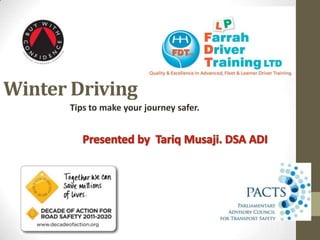Winter Driving
- 1. Winter Driving Tips to make your journey safer.
- 2. Prepare your Vehicle âĒ Lights are clean and working âĒ Battery is fully charged. âĒ Washer bottle fluids are topped up âĒ Tyres are in road worthy condition âĒ Oil is checked and if need be, topped up. âĒ Correct level of antifreeze & brake fluid levels.
- 3. âĒ Tow rope âĒ A shovel / ice scraper âĒ De â icer (s) âĒ A working torch âĒ Blanket âĒ Emergency food â biscuits, sweets , hot drink but no alcohol âĒ Mobile phone + in car charger âĒ Reliable Sat - Nav
- 4. âĒ Reduce your speed. The chances of skidding are much greater, your stopping distance will increase greatly. âĒ Skids are usually down to driver errors. âĒ Drive at a speed at which you can stop within the distance you can see to be clear. (Highway code rule 126) âĒ Avoid harsh braking, acceleration or sharp steering. âĒ Always reduce your speed smoothly and in plenty of time on slippery surfaces. âĒ To brake on ice or snow, get into a lower gear earlier than normal, allowing your speed to fall, then brake gently.
- 5. As and advanced driver you are a much safer driver. Benefits to your are: âĒ Reduced fuel consumption as you know about Eco-driving âĒ This in turn cuts down on your wear and tear. âĒ Less risk of being involved in a RTC (Road traffic collision) âĒ Reduced insurance premiums up to 20% saving with some Insurance companies. Thank You and drive safely.





